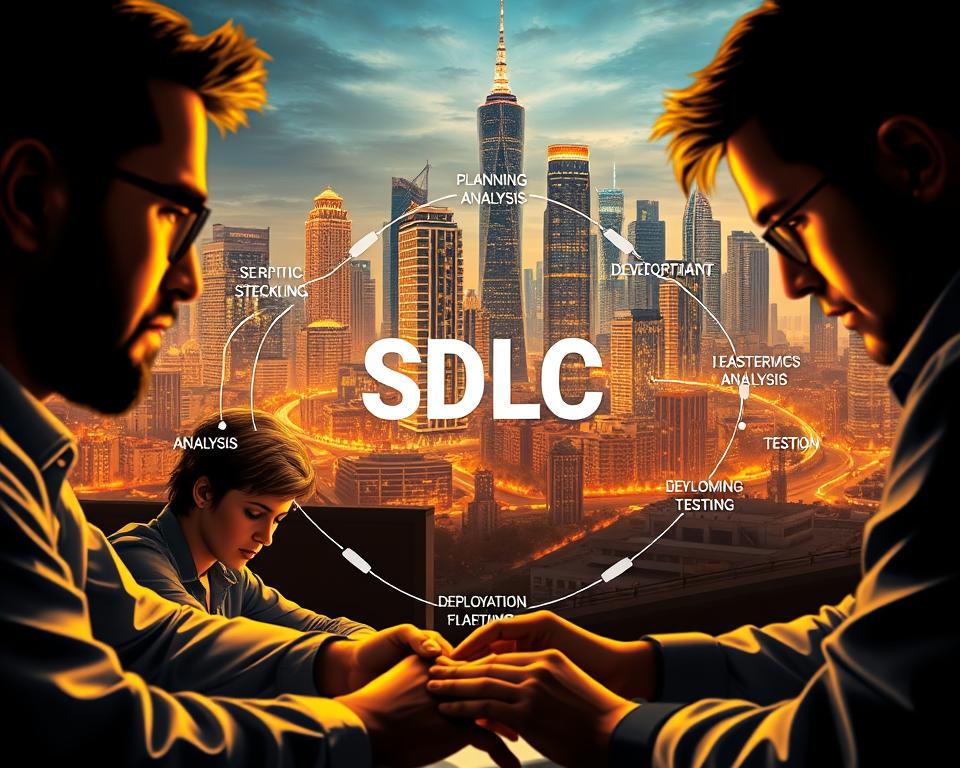
Exploring the Diverse World of Software Development
Did you know that the demand for software developers is projected to grow by 22% from 2019 to 2029, significantly faster than the average for all occupations? This astounding figure underscores the critical role software plays in our daily lives and business ecosystems. As technology continues to evolve, understanding the different types of software development and the various software development methodologies becomes increasingly essential. From enhancing productivity to driving innovation, the future trends in software development are poised to reshape how organizations function. Let’s dive deeper into this intricate landscape and understand what makes software development such a vital field.

Key Takeaways
- The software development industry is rapidly expanding, with a projected growth rate of 22% over the next decade.
- Understanding various software development methodologies is crucial for effective project management.
- Future trends in software development are shaping business strategies and operational efficiency.
- There are multiple approaches to software development, each with its unique benefits and challenges.
- Staying informed about the latest advancements in software development can give businesses a competitive edge.
Overview of Software Development
Software development serves as the backbone of modern technology, encompassing a range of activities focused on creating software applications, frameworks, and tools. This software development overview highlights the foundational aspects that define this dynamic field. Key components include coding, debugging, and deployment, which are essential for delivering functional and efficient applications.
In today’s software development landscape, collaboration among diverse teams leads to innovative solutions tailored for various platforms. Industries ranging from finance to healthcare rely on effective software to streamline processes, enhance user experience, and drive growth. Understanding the intricacies of software development is crucial for adapting to the fast-paced technological advancements that continually shape our world.
Organizations such as the Agile Alliance and PMI provide valuable insights into best practices within the software development process. These resources enhance comprehension of project management approaches, improving overall outcomes. As we delve deeper into this subject, recognizing the critical role of software development in solving contemporary challenges will underscore its importance in our daily lives.
The Importance of Software Development in Today’s World
The significance of software development cannot be overstated in today’s technological landscape. As businesses adapt to the fast-paced digital environment, the role of software becomes increasingly vital. Custom-built applications, ranging from e-commerce solutions to internal management software, enhance efficiency and improve user engagement.
Market statistics reveal a robust growth trend in software utilization. According to research from Gartner, organizations focused on software development experienced a notable ROI. The increase in investments towards technological solutions demonstrates the pivotal role software plays in modern business operations.

Various sectors, including healthcare, education, and retail, highlight the practicality of well-developed software systems. In healthcare, technologies streamline patient management systems, contributing to better health outcomes. In education, software tools facilitate remote learning, making education accessible. These examples illustrate how software in modern business transforms everyday operations, enhancing productivity and connection.
Investing in software development not only aligns with current business trends but also prepares organizations for future challenges. Companies leveraging innovative software solutions remain competitive, adapting swiftly to market demands. This emphasis on software development ultimately shapes the operational landscape, fostering growth and efficiency across industries.
Different Types of Software Development
The realm of software development encompasses various types that cater to distinct needs and functionalities. One prominent category is web application development, which is divided into two critical domains: front-end and back-end development. Front-end development focuses on the visual aspects of an application, utilizing technologies like HTML, CSS, and JavaScript. Frameworks such as React and Angular enhance the user interface, ensuring responsiveness and an engaging user experience. Development practices emphasize the importance of responsive design, aligning with best practices championed by experts.
On the other hand, back-end development manages the server-side logic and database interactions essential for functionality. Key programming languages in this domain include Python, Ruby, and Java, often accompanied by database management technologies such as SQL and NoSQL solutions.
In addition to web applications, mobile app development encompasses the creation of applications specifically designed for iOS and Android platforms. This area leverages tools such as Swift for iOS and Kotlin for Android. Furthermore, cross-platform solutions like Flutter and React Native provide developers with the capability to build apps that run seamlessly on both systems, making development more efficient.
Enterprise software development is another vital segment, focusing on tailored solutions for larger organizations. These solutions can range from CRM systems to ERP software, addressing unique business requirements. Real-world applications from companies like Salesforce and SAP demonstrate the significant impact of custom software in enhancing business operations and workflow management.
Software Development Methodologies
Software development methodologies play a crucial role in shaping the outcomes of coding projects. Diverse methodologies in coding cater to different project needs, allowing teams to navigate complexities effectively. Understanding these methodologies can enhance project management and promote successful deliverables.
Among the most popular approaches are Agile, Waterfall, and Spiral methodologies. Each has its unique advantages and drawbacks:
- Agile: Focuses on iterative progress through collaborative teams, making it suitable for projects that require flexibility and rapid adaptation to changing requirements.
- Waterfall: This linear approach works best for projects with well-defined stages. Its predictable structure facilitates easy planning, though it may struggle with unexpected changes.
- Spiral: Combines elements of both iterative development and systematic risk assessment. This approach is beneficial in managing risks while progressively refining project outcomes.
Selecting the right software development methodology hinges on various factors such as project scope, team dynamics, and client expectations. Understanding the nuances of available options allows businesses to identify the most suitable approach for their specific context.
Understanding the Software Development Life Cycle
The software development life cycle (SDLC) provides a structured approach to developing software applications effectively. This cycle encompasses various SDLC phases, each serving its unique purpose in crafting quality software. The initial phase, planning, sets the foundation by identifying project goals and feasibility. Following this is requirements gathering, where teams collect and define the functional and non-functional requirements necessary for the software.
After requirements gathering, the design phase takes center stage, focusing on creating the architecture and interface. This visual framework guides developers during implementation. Once the software is built, the emphasis shifts to testing. This critical phase ensures functionality, performance, and user satisfaction by identifying and resolving defects before deployment.
After successful testing, the deployment phase marks the transition to making the software available to users. Effective deployment strategies can facilitate a smooth launch, minimizing disruptions. Lastly, maintenance ensures that the software remains functional and user-friendly, incorporating necessary updates and enhancements.
Documentation throughout each SDLC phase is crucial. Clear records help maintain alignment between stakeholders and developers, fostering collaboration. By actively involving stakeholders at every stage, teams can ensure the final product meets user expectations and business goals.
| SDLC Phase | Description | Activities Involved |
|---|---|---|
| Planning | Establish project goals and scope | Feasibility studies, project charter creation |
| Requirements Gathering | Define functional and non-functional requirements | Interviews, surveys, and workshops with stakeholders |
| Design | Create architecture and interface | Wireframes, user interface designs, technical specifications |
| Implementation | Develop the software | Coding, integration of various components |
| Testing | Identify and resolve defects | Unit testing, integration testing, user acceptance testing |
| Deployment | Launch the software to users | Release planning, user training, system configuration |
| Maintenance | Ensure ongoing functionality | Bug fixes, updates, user support |
Agile Software Development: A Closer Look
Agile software development has transformed the tech landscape by emphasizing flexibility, collaboration, and iterative progress. Unlike traditional methods, the Agile methodology fosters an environment where teams can adapt quickly to changes, enhancing the overall efficiency of projects. This approach allows for regular feedback and adjustments, which are crucial in today’s fast-paced development world.
Two popular frameworks within Agile software development are Scrum and Kanban. Scrum focuses on structured iterations called sprints, enabling teams to prioritize tasks and boost productivity through regular meetings and reviews. Kanban, on the other hand, visualizes tasks on boards, promoting continuous delivery and flexibility by allowing teams to pull work as capacity allows.
The Agile Alliance highlights various success metrics that indicate the effectiveness of Agile practices. These metrics often include aspects like customer satisfaction, team velocity, and delivery timelines. Case studies reveal that organizations adopting Agile methodology report improved project outcomes, increased customer engagement, and higher team morale.
In summary, Agile software development stands out due to its ability to adapt swiftly while maintaining a focus on collaboration and continuous improvement. Understanding frameworks like Scrum and Kanban is essential for teams aiming to harness the full potential of Agile methodology in their projects.
The Waterfall Model: Traditional Approaches to Software Development
The Waterfall model represents a traditional software development methodology known for its linear and sequential approach to project management. This model consists of distinct phases, including requirements gathering, system design, implementation, testing, deployment, and maintenance. Each phase must be completed before moving on to the next, providing a structured pathway for project execution.
One of the key benefits of the Waterfall model is its simplicity and ease of use. Project managers can easily track progress and ensure that all requirements are documented thoroughly. The structured nature allows teams to manage resources efficiently, ensuring that time and budget constraints are respected.
Despite these advantages, the Waterfall model presents some limitations. Its inflexibility to change means that adapting requirements mid-project can lead to significant setbacks. This can be particularly challenging in fast-paced environments where needs might evolve. Moreover, issues discovered during the testing phase can require revisiting earlier stages, leading to added delays and costs.
Case studies have shown successful implementations of the Waterfall model in various industries. For example, large-scale projects in the aerospace sector often benefit from its regulated and methodical structure, allowing for intricate systems to be developed with precise compliance to standards.
Exploring Iterative Model in Software Development
The iterative model stands out in the realm of software development due to its cyclical approach, enabling teams to refine their projects through repeated cycles. This iterative development process facilitates regular feedback from users at every iteration, allowing developers to make adjustments promptly rather than waiting until the end of a project.
One of the key advantages of the iterative model is its ability to adapt to changing requirements. Many projects begin with a set of expectations, but as development progresses, these expectations can shift. Incorporating user feedback throughout the iterative development process ensures that the final product aligns more closely with user needs.
Despite its advantages, challenges do exist when utilizing the iterative model. Maintaining clear communication among team members and managing user expectations can become complex as feedback and revisions accumulate. Properly managing these aspects is crucial to ensuring a smooth and productive iterative development process.
Prototyping Model: Enhancing Software Development
The prototyping model stands out in software development due to its emphasis on early user involvement. Businesses leverage rapid prototyping techniques to create preliminary versions of software, enabling stakeholders to visualize and interact with the product. Rapid prototyping fosters a collaborative atmosphere where user feedback plays a significant role in shaping the final outcome.
The benefits of prototyping extend beyond just user engagement. This method allows developers to identify potential flaws early in the project lifecycle, leading to fewer revisions and an overall reduction in development time. By refining concepts through continuous iterations, teams can ensure the final product aligns more closely with user expectations.
Despite its advantages, the prototyping model is not without drawbacks. The challenges in prototyping often include scope creep, which can occur as evolving project requirements may extend beyond initial specifications. This often results in misestimations regarding resources and project timelines. Various industries have encountered these issues, demonstrating the delicate balance required in managing expectations and maintaining project focus.
The Spiral Model: Merging Iteration with Risk Management
The Spiral model represents a unique approach in the realm of software development, blending iterative processes with a strong emphasis on risk management. Developed by Barry Boehm, this model is particularly beneficial for complex and large-scale projects that require ongoing risk assessment throughout their life cycles.
Each loop of the spiral indicates a specific phase that incorporates key elements like planning, risk analysis, and engineering. As teams progress through the spiral, they can actively assess potential risks at each stage, making adjustments as necessary. This continuous evaluation aids in identifying challenges early on, thereby mitigating potential issues that could affect project outcomes.
Learners and professionals alike often appreciate the Spiral model for its adaptability. It allows for flexibility in development while ensuring that risk management in software development remains a primary focus. Such adaptability is vital in today’s fast-paced tech environment, where changes can happen rapidly and unpredictably.
| Spiral Model Phases | Key Activities | Risk Management Techniques |
|---|---|---|
| 1. Planning | Define objectives, deliverables, and timelines. | Identify potential risks and their impact. |
| 2. Risk Analysis | Analyze identified risks and possible solutions. | Develop mitigation strategies. |
| 3. Engineering | Create and test prototypes. | Implement feedback loops for revision. |
| 4. Evaluation | Review deliverables and assess project progress. | Adjust risk management plans based on evaluation. |
This structured yet flexible framework helps teams stay proactive regarding risk, ensuring that all aspects are evaluated systematically. By embracing the Spiral model, organizations can enhance their risk management in software development, ultimately leading to more successful project completions.
Types of Programming Languages Used in Software Development
In the realm of software development, programming languages are categorized into two primary types: high-level programming languages and low-level programming. High-level programming languages, such as Python and Java, are designed for ease of use and abstraction from the hardware. These languages allow developers to write code more intuitively, enhancing productivity and collaboration.
Low-level programming, exemplified by languages like C, provides developers with fine control over system resources and hardware interactions. This level of control is crucial for tasks that require optimization and efficiency, such as embedded systems and operating system development. Understanding these differences is vital for selecting the right language for specific project needs.
Scripting languages play a significant role in modern software development. Languages like JavaScript and Ruby enhance automation, user experience, and overall functionality in web environments. They enable developers to quickly create interactive web applications and facilitate software testing, proving invaluable in today’s software landscape.
When choosing between these coding languages, consider the project goals, team expertise, and the final application’s requirements. Each language offers unique strengths that contribute to the overall effectiveness of development strategies.
Choosing the Right Software Development Methodology for Your Project
Selecting the appropriate software development methodology is crucial for project success. Different methodologies cater to various project needs, making it essential to evaluate specific factors before making a decision. Key aspects to consider include project size, resource availability, and the level of client involvement.
For smaller projects, agile methodologies often enhance flexibility and responsiveness. In larger environments, adopting a structured approach like Waterfall may be beneficial for managing complexities. Each methodology brings its own set of project management strategies that align better with certain types of work.
Industry surveys highlight trends in methodology preferences across sectors. Understanding these preferences can guide teams in selecting a methodology that resonates with their objectives, promoting efficiency and effectiveness throughout the project lifecycle. Embracing the right project management strategies empowers teams to streamline workflows and enhance collaboration, ultimately leading to superior outcomes.
Future Trends in Software Development
The future of software development is poised for significant transformations, driven by emerging tech trends. A major highlight on the horizon involves the rise of AI-driven development, where artificial intelligence will play a crucial role in automating coding and optimizing processes. This transition promises to enhance productivity while reducing human error.
Another noteworthy trend is the increasing adoption of low-code and no-code platforms. These tools empower individuals without extensive programming backgrounds to develop applications effortlessly. Such platforms democratize software creation and enable businesses to adapt quickly to changing market demands.
Cybersecurity will gain greater emphasis in software solutions. As digital threats evolve, developers must prioritize integrating robust security measures during the initial design and development phases. This shift toward a security-first approach will not only protect user data but also build trust in software products.
As organizations look to the future, they must stay alert to these transformative tech trends that will shape the landscape of software development. Adaptability and innovation will be essential for success in this rapidly changing environment.
Conclusion
In summary, the world of software development is as diverse as it is dynamic. Throughout this exploration, we have delved into various types of software development, methodologies, and the critical importance they hold in today’s technological landscape. The rapid evolution of programming languages and approaches—ranging from Agile to Waterfall—illustrates how adaptable software development needs to be to stay relevant and efficient in addressing ever-changing market demands.
As we reflect on this software development summary, it becomes apparent that continuous learning and flexibility are essential. The future of software development will likely be shaped by emerging trends such as artificial intelligence, machine learning, and cloud computing, pointing towards a landscape where innovation is the norm. To thrive in this environment, developers must remain informed and ready to embrace change.
In essence, software development is a key driver not only of technology but also of the broader societal advancements we experience today. Embracing the lessons learned from past methodologies while staying attuned to the future of software development will empower individuals and organizations alike to create impactful solutions that resonate with users and drive success.




